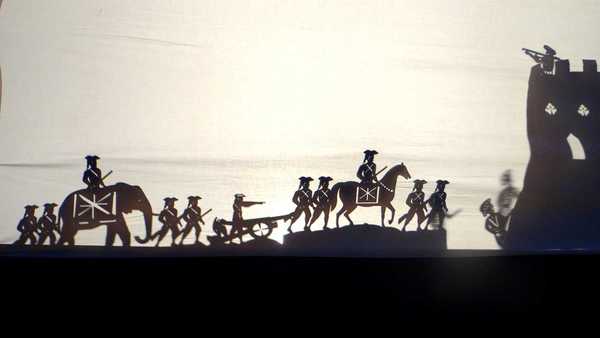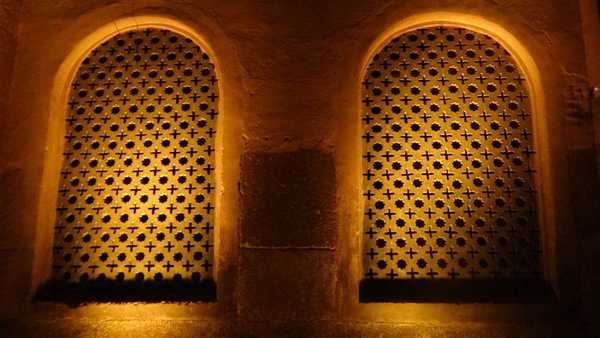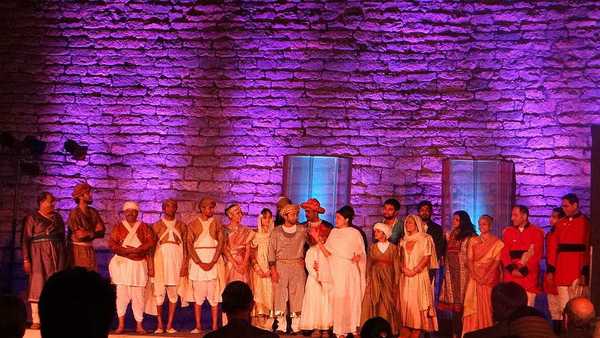Mother and father are discussing family matters. They deplore the mischief of their two boys, and also express wry amusement at the younger one’s original thinking, that lies behind the mischief. However, the father predicts that this boy will leave footprints on the sands of time, and go on to become famous.
Almost a scene played out in every home, one may feel…but it was, actually, a scene from a play on Tipu Sultan, by the late Dina Mehta, who was an award-winning playwright and Fiction Editor at the Illustrated Weekly of India.
The father in question in this play is no ordinary householder… he is Hyder Ali, and his son will, in time, will turn out to be the Tiger of Mysore…Tipu Sultan. And so, with this play and a landmark event, Tipu came home, briefly, to his own Fort in Bangalore.

Shadow play, staged by volunteers. Pic:DM
“The Tiger Comes to Town” was a very interesting multi-media project, organised on the occasion of the 150th anniversary of the Archaeological Society of India (ASI). The Centre for Public History (CPH) of the Srishti School of Art, Design and Technology (SSADT), the Archaeological Society of India (ASI), and the Bangalore Little Theatre (BLT), all played their parts in bringing this event before the public, in the historic premises of the Bangalore Fort…a first for our city. The event was sponsored by Ganjam, the noted jewellers of Bangalore.
This is the first time in Bangalore that a historic venue has been thrown open for holding such an event, and staying a historical play.
The project focused on the Bangalore Fort, and had an amalgam of events from October through December 2012. It included Docent Walks (guided walks) by the students of SSADT for the general public, a shadow puppet play tent for young visitors, information panels, a booklet on aspects of the fort, soundscapes from oral history (recorded interviews conducted with local communities), a lecture series focusing on science and technology in the 18th century (especially Tipu’s fascination for rockets) and a site-specific theatre performance.
The tiger was chosen as a motif, as Tipu himself chose the animal to embellish his soldiers’ uniforms, coins, flags, weapons, armour, and even his throne. A beautiful booklet, produced by CPH, described about the various aspects of Tipu’s life and kingship. The information panels, set up at various points around the fort, gave a lot of information, historic and contemporary, to visitors.
The short shadow play sessions conducted by the students ran to packed houses. Several children found their sense of history being awakened…as did the adults with them! The shadow play depicted the Battle for Bangalore, when Lord Cornwallis, aided by the treachery of Tipu’s trusted lieutenants, fought Tipu and breached the fort, resulting in the ultimate defeat and death of Tipu Sultan.
The lighting of the fort was very striking, and Shashank Purushottam, the President of Bangalore Little Theatre, and and his team, deserve praise for the historical stage-set, beautifully lit up in the dark.

Lighting of the “jaali” windows of the Fort. Pic: DM
Naturally, the play, “Tiger! Tiger!” was the highpoint of the event. For a description of the “History of Ideas” programme, that this play was a part of, click here.
Aliyeh Rizwi, the former President of BLT, who directed the play ably, ensured that every member of the cast (including the volunteer “guards”!) played their roles extremely well. The play was an unusual depiction of Tipu — instead of focusing on him as a king and a warrior, it delineated the inner trauma and dilemmas of a man who would “rather be a philosopher than a king”… and the outer conflicts of court intrigue, conspiracy, and betrayal.
The period costumes were also extremely well done. Sometimes, the cumbersome robes of the 18th century can be difficult to move around in; turbans have a way of falling off in mid-performance; but no such mishaps were visible during the performance. Padmaja Nagarur, who played Fakhr-un-Nissa, the mother of Tipu, joked that sometimes the stage itself was not too stable!
I was also struck by the quality of the audio during the performance. Amazingly, the noise of the traffic outside the Fort (and it is a very noisy neighbourhood!) did not percolate into the inner quadrangle, at all, and most of the dialogue was very clear indeed. The microphones and the speakers, placed carefully around the quadrangle, worked marvellously.
Simple stage props made up the set design, and it was the script and the actors who were highlighted.
The only nit I have to pick was that the actors did start raising their voices too much towards the end of the play, as the content got more intense and emotional. Also, the words of the “Englishmen” were not always clear to the listeners, and some grumbling was heard amongst the audience. But it’s a known story, the tragedy of Tipu’s betrayal…so it didn’t cause much of a hitch in the proceedings.

The cast after the show. Pic: DM
A sense of history
Though the fort sits in the heart of our city, little is talked or discussed about it by lay residents. The people of the locality go about their trade and commerce not particularly aware of, or appreciative of, the landmark in their midst. Indeed, the walls of the fort seem to support a whole host of traders, hawking varied wares, oblivious of the history in the stones behind their backs!
The students of the Srishti School had researched this aspect of the historic Fort. They decided to rely on secondary sources as well as archival research. In 2012, for a period of three months, they concentrated on the iconography and the architecture of the 18th century, and examined both legends and stories of the local people, to arrive at an understanding of how to make their own narratives about the fort compelling to their listeners, during the conducted walks.
The Battle for Bangalore, fought on March 21, 1791, between Lord Cornwallis and Tipu, was obviously, a turning point in the history of the fort. The fort later fell into disuse as war technology and the importance of the region changed. Today, it stands, a jewel from the past, in the middle of a bustling marketplace.
Another source used by the project is “Tipu’s Dream Diary”, which was found by Colonel Kirkpatrick in the inner chambers of Srirangapatna after Tipu’s death. This diary records over 37 dreams in a period of 13 years, from 1785 to 1798. The diary was translated from Persian into English in 1800, and dated according to the “Mouladi”…a calendar created by Tipu himself. The dreams are varied, but they show his preoccupation with the British, whom he regarded as his main enemies.
As the SSADT project drew to a close, two pieces of cannon, probably from Tipu’s foundry, were accidentally excavated on the construction site of the Bangalore Metro Railway, not far from the fort. Once again, the past had resurfaced in the present!
The students of SSADT feel, unanimously, that the local residents need to realise the importance of this landmark amidst them; Though the ASI preserves the structure, its value in terms of the history of the city needs to be re-stressed so that Bangaloreans take fresh pride in this bastion where a king tried his level best to repudiate and defeat the British Raj, and died heroically in the effort.⊕
Such events depicting the history of he city are very welcome. Light and Sound shows are there for many heritage sites all over the world. Hope these shows are repeated. There is a plaque on the wall of the fort which talks about the battle. It needs better preservation
For more pictures of the event,
please click here
Some of the volunteers I met at the Shadow Play tent were Sachin, Meera, and Samyudaya.
informative, sustains interest, strikes a chord in the heart. Thank you Deepa.
You’re very welcome, Vaijayanthi 🙂
To know the “real story” of Tipu Sultan, you should read the book corrected by his own son Golam Mohammed.
Name of the book: Haidar Ali and Tipu Sultan and the Struggle with the Musalman Powers of the South
Link: http://www.foyles.co.uk/mpitem/marketplace/haidar-ali-and-tipu-sultan-and-the-struggle-with-the-musalman-powers-of-the-south,lewin-b-bowring-9788120612990
Also, you can read about Tipu here: http://voiceofdharma.org/books/tipu/ch04.htm
Thank you for this informative link, Narendra Kumar.